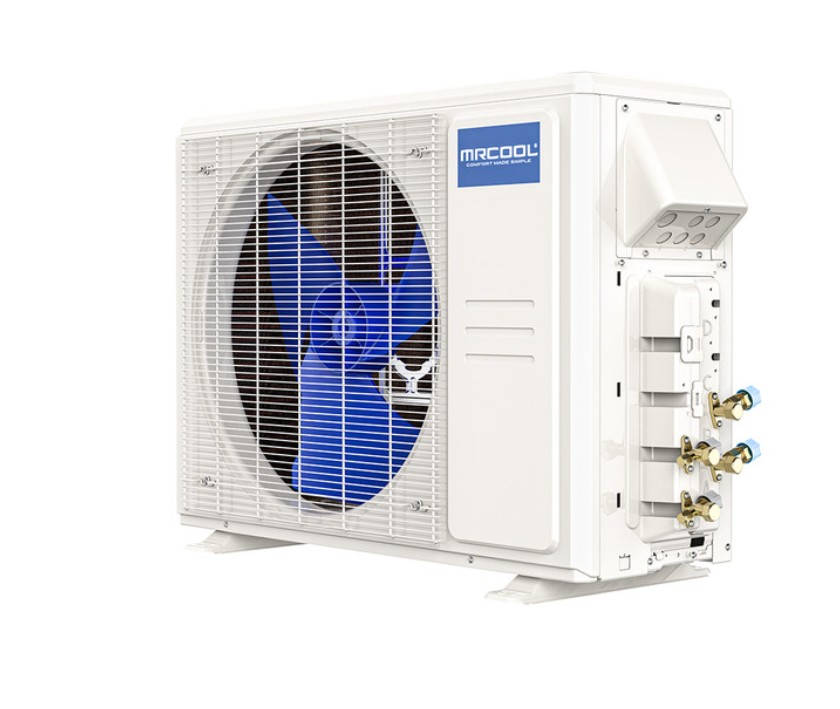Are you searching for an efficient and budget-friendly way to heat and cool multiple rooms in your home? A DIY multi-zone condenser could be the perfect solution. This system allows you to control the temperature in different areas independently, ensuring personalized comfort while saving on energy costs.
Unlike traditional central HVAC systems that require complex ductwork and professional installation, a DIY condenser is designed for homeowners who prefer a hands-on approach. With pre-charged refrigerant lines and a straightforward installation process, setting up your system has never been easier.
This guide will cover everything you need to know, including how these systems work, their key benefits, important factors to consider before purchasing, a step-by-step installation guide, and maintenance tips to ensure longevity.
What Is a DIY Multi-Zone Condenser?
A DIY multi-zone condenser is the outdoor unit of a ductless mini-split HVAC system. It connects to multiple indoor air handlers, each responsible for heating or cooling a specific zone within your home. Unlike traditional forced-air systems that distribute air through ducts, a multi-zone system eliminates ductwork, reducing installation complexity and energy loss.
The outdoor condenser is responsible for compressing and circulating refrigerant to the indoor units. Each indoor air handler operates independently, meaning different rooms can be set to different temperatures based on personal preferences. This level of control makes it an excellent option for homes where occupants have varying comfort needs.
How Does It Work?
A condenser operates using a simple yet efficient process:
- The outdoor condenser compresses and circulates the refrigerant, which travels through refrigerant lines to the indoor air handlers.
- Each indoor unit draws in warm air, cools or heats it using the refrigerant, and then releases conditioned air into the room.
- Because the indoor units work independently, users can adjust temperatures in each zone separately using remote controls, smart thermostats, or mobile apps.
- When cooling, the system removes heat from the indoor air and expels it outside. During heating mode, the process reverses, extracting heat from outdoor air and transferring it inside.
This technology ensures that only occupied spaces receive heating or cooling, improving efficiency and reducing unnecessary energy consumption.
Benefits of Installing This System
Cost Savings
One of the most significant advantages is cost reduction. Professional HVAC installations can be expensive, with labor alone costing thousands of dollars. By choosing a DIY system, homeowners can eliminate installation fees while still getting a high-performance heating and cooling solution.
Energy Efficiency
Traditional HVAC systems often waste energy by heating or cooling the entire home, even in unoccupied areas. A multi-zone system allows you to control individual room temperatures, ensuring energy is only used where needed. This zoning capability significantly reduces utility bills over time.
Easy Installation
Most multi-zone condensers come with pre-charged refrigerant lines, eliminating the need for specialized HVAC tools. This makes installation much simpler than traditional systems, allowing homeowners with basic handyman skills to complete the setup without professional assistance.
Personalized Comfort
A major drawback of central HVAC systems is the inability to set different temperatures in different rooms. A multi-zone condenser solves this issue by giving each occupant control over their comfort. Whether someone prefers a cooler bedroom while another enjoys a warmer living space, these systems allow full customization.
Compact and Space-Saving
Since these systems do not require bulky ductwork, they take up much less space. The indoor air handlers are sleek and mounted on walls or ceilings, freeing up valuable floor space. The outdoor condenser is also compact, requiring only a small area outside the home.
Low Maintenance and Longevity
With fewer moving parts than traditional HVAC systems, a DIY multi-zone condenser requires minimal maintenance. Routine filter cleaning and occasional refrigerant level checks are all that are needed to keep the system running efficiently. When properly maintained, these units can last between 15 to 20 years.
Choosing the Right System
When selecting a system, it is important to consider several factors to ensure it meets your specific needs.
Number of Zones
Different condensers support varying numbers of indoor units. Some models can handle two zones, while others support up to five or more. It is essential to determine how many rooms you need to heat or cool before purchasing.
BTU Capacity
British Thermal Units (BTUs) measure the system’s heating and cooling capacity. Choosing the right BTU rating ensures optimal performance. A unit with too low a capacity will struggle to maintain temperatures, while an oversized unit may short-cycle, reducing efficiency.
Voltage Requirements
Some DIY multi-zone systems operate on standard 115V outlets, while others require a 230V power source. Checking your home’s electrical capacity beforehand will help avoid installation issues.
Smart Features
Many modern systems come with advanced features like Wi-Fi connectivity, smartphone app control, and voice activation through smart assistants like Alexa or Google Home. These features provide added convenience and allow for energy-saving automation.
Warranty and Support
A reliable manufacturer will offer a strong warranty, typically covering parts and compressors for five to ten years. Customer support is also an important factor, as troubleshooting issues may arise during installation or operation.
Step-by-Step DIY Installation Guide
Selecting the Right Location
The outdoor condenser should be placed in a well-ventilated area, away from direct sunlight and obstructions. The indoor air handlers should be mounted at least six to eight feet high, ensuring proper airflow and efficient cooling or heating.
Installing the Mounting Brackets
Each air handler requires a sturdy mounting bracket, which should be attached securely to the wall. Proper leveling is crucial to ensure even airflow and efficient operation.
Connecting the Refrigerant Lines
Pre-charged refrigerant lines should be connected according to the manufacturer’s instructions. Ensuring a tight, leak-free connection is essential for optimal performance.
Electrical Wiring
The system must be plugged into the correct voltage source. Some models require a dedicated circuit breaker to prevent electrical overload.
Testing the System
Once installation is complete, turning on the system and adjusting temperature settings will help confirm that each zone is functioning correctly. Checking airflow and refrigerant levels ensures that the system operates at peak efficiency.
Maintenance Tips for a Longer Lifespan
To keep your condenser running smoothly, follow these simple maintenance steps:
- Clean or replace filters every two to three months to prevent dust buildup.
- Inspect refrigerant lines for leaks or wear.
- Keep the outdoor condenser free from debris, leaves, and dirt.
- Schedule routine electrical checks to avoid wiring issues.
Is a DIY Multi-Zone Condenser Right for You?
If you want an affordable, energy-efficient, and customizable heating and cooling system, a DIY multi-zone condenser is a great investment. These systems provide long-term savings, improved home comfort, and an easy installation process that makes them ideal for homeowners who enjoy DIY projects.
Conclusion
A DIY multi-zone condenser is a cost-effective and efficient way to heat and cool multiple rooms independently. With its easy installation, energy-saving benefits, and smart technology, it is an excellent choice for homeowners looking to upgrade their HVAC systems. If you want to cut costs and take control of your home’s comfort, now is the perfect time to upgrade to a multi-zone system. Enjoy efficiency, convenience, and customized temperature settings in every room.
Upgrade your home with a DIY multi-zone condenser from Mass HVAC Distributors today! Enjoy easy installation, lower energy bills, and year-round comfort. Browse our top-rated models and take control of your indoor climate now.





